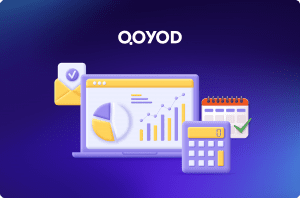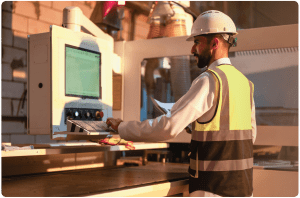| Excerpt EBITDA (Earnings Before Interest, Taxes, Depreciation, and Amortization) is a vital financial indicator that measures the true operational efficiency of Saudi companies, particularly SMEs, by stripping profits of financing, tax, and accounting effects. This metric is used for fair comparison between businesses and assessing earnings quality, serving as an essential analytical tool that should be used alongside other metrics for a complete view before making investment or management decisions. |
Introduction
Understanding the true financial health of a business is crucial for investors and managers in the fast-paced world of finance and business, especially for small and medium-sized enterprises (SMEs) in Saudi Arabia . The ability to accurately analyze corporate performance is fundamental to making successful financial decisions. Here, the metric of EBITDA (Earnings Before Interest, Taxes, Depreciation, and Amortization) emerges as a precise tool that offers a clearer view of actual operational performance, stripped of accounting noise.
This metric is essential for assessing the strength of a company’s core activities. Simply put, EBITDA answers one critical question: “Is the company truly profitable from its core business operations, or are the reported profits merely a reflection of financing or accounting processes?”
In this article, we provide a detailed knowledge journey, defining what EBITDA is, detailing the steps to calculate it accurately, differentiating it from indicators like EBIT, exploring its benefits and limitations, and demonstrating how to practically leverage it to support your investment and management decisions in local markets like Riyadh, Jeddah, and Dammam. This insight is vital for navigating the e-invoicing system in Saudi Arabia and managing local tax requirements, such as Zakat and VAT.
What is EBITDA (Earnings Before Interest, Taxes, Depreciation, and Amortization)?
The acronym EBITDA stands for Earnings Before Interest, Taxes, Depreciation, and Amortization. It is a financial indicator used to estimate a company’s ability to generate profit from its core operating activities, independent of the effects of financing, taxes (like VAT and Zakat), and non-cash accounting factors such as Depreciation and Amortization.
EBITDA is a vital financial tool used to measure a company’s operational performance clearly, isolated from the accounting and financial variables that can influence the final profitability result.
What Does the EBITDA Metric Mean?
EBITDA has emerged as a key benchmark for measuring operational efficiency and profitability in modern financial markets, providing a purely practical approach that moves beyond traditional accounting complexities.
This metric assesses the company’s net income by looking only at its core commercial operations, excluding accounting factors that can obscure the overall picture, such as interest, taxes, depreciation, and amortization expenses. Consequently, EBITDA provides a more realistic and fair view of a company’s operational efficiency and profitability, allowing for a deeper understanding of its actual cash-generating capability.
It is particularly valuable for comparing company performance across multiple sectors, especially those subject to varying tax rates or diverse financing strategies, which is common among diverse businesses in Saudi Arabia. EBITDA is a crucial indicator for evaluating investment opportunities, determining market value, and supporting financing and expansion decisions.
In essence, this metric represents the profits a company generates from its fundamental operations, before deducting costs related to interest on debt, taxes (e.g., ZATCA compliance), and the amortization/depreciation of tangible and intangible assets. It helps separate the actual performance of the commercial activity from external factors that might affect final results, such as the company’s debt or tax obligations.
Further Reading:
- [Learn about the E-Invoicing System in Saudi Arabia (Fawateer)]
- [What is a Tax Invoice in Saudi Arabia?]
The Difference Between EBIT and EBITDA
The difference between EBITDA and EBIT (Earnings Before Interest and Taxes) can be clearly understood through the following table:
| Differentiating Factor | EBIT | EBITDA |
| Definition | Earnings Before Interest and Taxes. | Earnings Before Interest, Taxes, Depreciation, and Amortization. |
| Calculation Method | Revenues – Operating Expenses (excluding Interest and Taxes). | EBIT + Depreciation + Amortization. |
| What it Reflects | The operational profitability of the company. | The company’s cash flow potential and capacity for future investment. |
| Non-Operating Expenses | Not taken into account (e.g., Depreciation and Amortization). | Added back to EBIT to provide a clearer picture of cash flows. |
| Suitable Industries | All industries, especially those without heavy capital expenditures. | Industries with high capital expenditures, such as manufacturing and construction in Dammam or Jeddah. |
| Usefulness | Offers a clear view of operational profitability but may not reflect actual cash flows. | Provides a better picture of cash flow potential, but can be slightly misleading as it doesn’t represent actual cash outflows. |
| Application | Generally used to assess a company’s internal operating performance. | Specifically used in capital-intensive industries. |
How to Calculate EBITDA for Saudi SMBs
Essential Inputs for EBITDA Calculation
To accurately calculate EBITDA, four key inputs, typically available in a company’s financial records (easily tracked with Qoyod Accounting Software), are required:
- Interest
- Taxes (e.g., VAT, Zakat)
- Depreciation
- Amortization
Data Sources
- Interest and Taxes: Found in the Income Statement.
- Depreciation and Amortization: Data is usually obtained from the notes to the operating profits or the Cash Flow Statement.
Calculating EBITDA
EBITDA is calculated by adding Depreciation and Amortization expenses back to EBIT, as per the following formula:
EBITDA = Operating Profit + Depreciation + Amortization
Further Reading:
Example Calculation for a Saudi Business
Let’s assume a company in Khobar generates the following revenues and expenses:
- Revenues: SAR 80 million
- General Expenses: SAR 15 million
- Cost of Goods Sold (COGS): SAR 35 million
- Operating Profit
Operating Profit = Revenues − General Expenses − COGS
Operating Profit = 80 − 15 − 35 = SAR 30 million - Earnings Before Interest and Taxes (EBIT)
If Depreciation and Amortization = SAR 7 million:
EBIT = Operating Profit − (Depreciation + Amortization)
EBIT = 30 − 7 = SAR 23 million - Earnings Before Taxes (EBT)
If Interest = SAR 3 million:
EBT = EBIT − Interest
EBT = 23 − 3 = SAR 20 million - Net Income
If Tax rate = 20%:
Taxes = EBT × 20%
Taxes = 20 × 0.20 = SAR 4 million
Net Income = EBT − Taxes
Net Income = 20 − 4 = SAR 16 million - EBITDA
EBITDA = Net Income + Interest + Taxes + Depreciation + Amortization
EBITDA = 16 + 3 + 4 + 7 = SAR 30 million
In this example, the EBITDA of SAR 30 million reflects the company’s operational profit-generating ability, untouched by accounting and financing factors.
Why Do Saudi Businesses Need the EBITDA Metric?
Companies often vary in their financing structures and accounting policies, making comparisons difficult. By using EBITDA, investors and analysts can assess operational efficiency alone, without results being skewed by differences in loans, taxes, or accounting policies.
For example, two Saudi companies in the same sector might generate the same revenue, but one carries significant debt while the other does not. In this case, the EBITDA metric provides a fair and neutral perspective on their actual operating performance, without bias.
Why is EBITDA Considered Important?
- Deep Insight into Operational Performance: It removes the effect of non-cash expenses and separates the company’s performance from debt and tax impacts, essential for accurate analysis of Riyadh‘s competitive market.
- Better Company Comparisons: It’s used to compare companies of various sizes and sectors without confusion caused by differing financial structures or tax rates.
- Informed Investment Decisions: It allows investors to evaluate the company’s efficiency in managing its core operations and generating operational profits.
The Difference Between Accounting and Operational Profit
A company may show high profits on its financial statements, but these profits could result from non-operating activities like the sale of an asset or an external investment. EBITDA, however, focuses only on profits generated from the company’s core activity, such as manufacturing, selling, or providing services. This makes it one of the most important indicators in modern financial analysis, as it reflects the quality of earnings, not just the quantity.
Further Reading:
Goals and Advantages of EBITDA
EBITDA acts as a mirror to a company’s efficiency in generating profits from its core operations. A higher value indicates a company’s ability to generate strong cash flows that can be invested in expansion, debt repayment, or improved operational efficiency. More importantly, tracking the evolution of this metric over time helps to determine the company’s true growth trajectory and financial stability.
Companies today aim to strike a delicate balance between sustainable profits and long-term growth. In this challenge, EBITDA emerges as a financial tool that gives managers and investors a realistic perspective on the quality of earnings and operational efficiency. It is not used merely to calculate a number for financial reports but to form a deep understanding of the company’s ability to generate income from its core activities, free from any secondary influences.
The Core Goal of EBITDA
The fundamental goal of this metric is to evaluate a company’s net operational performance without considering financing, tax, or accounting factors that could compromise the clarity of the financial picture. It simply seeks to answer a core question for every investor or manager:
“Is the company generating real profits from its core activity, or are its earnings a result of temporary external factors?”
For instance, a company might show high profits on its financial statements due to tax cuts or the sale of an old asset. However, calculating EBITDA reveals the true picture, as it only highlights what has been achieved through daily operational activities. This makes the metric ideal for identifying:
- Real profitability from core operations.
- Management’s efficiency in deploying resources.
- The ability to achieve stable cash flows.
How Does the Metric Help Companies Understand Their Financial Performance?
EBITDA allows companies to separate financial performance from financing and accounting, enabling accountants and managers to analyze profits from a purely operational perspective. When Interest (related to loans) and Taxes (which vary from country to country, or due to Saudi Zakat Authority (ZATCA) rules) are excluded, along with Depreciation and Amortization (which are non-cash accounting items), what remains is the core business performance only.
For example: If a manufacturing company in Madinah registers a drop in its annual profits due to increased taxes, calculating EBITDA will clarify whether the issue lies in the operational performance itself or the tax burden. This allows management to make precise decisions to address the root cause.
Advantages of EBITDA
This metric’s popularity is not without reason; it offers a set of hard-to-ignore financial and analytical advantages:
- Objective Evaluation of Operational Performance
It enables investors to assess company performance objectively and fairly, as it ignores financing and tax effects that might vary from one company to another. This allows for accurate comparison between companies within the same sector, even if their financing situations or geographical locations differ. - Simplified Financial Data Reading
Financial statements are often complex and full of details that can confuse the average investor. EBITDA provides a clear, easy-to-understand summary that reflects the company’s ability to generate profits from its core activities without the need to dive into complex figures. - Highlighting Operational Cash Flows
One of the biggest advantages of this metric is that it provides a very close image of the real cash flow generated by operational activity. It clarifies how much money the company generates from its daily operations, which helps estimate its capacity for repayment and investment. - Improving Valuation and Investment Process
Financial analysts, banks, and investors rely on EBITDA as a key tool when evaluating companies for:
- Determining fair market value.
- Studying merger and acquisition (M&A) opportunities.
- Making financing or expansion decisions.
- Highlighting Operational Flexibility
During economic downturns, companies with high EBITDA can appear as more resilient and enduring entities because they possess strong cash flows resulting from genuine activity, making them more attractive to investors and funders.
How Does EBITDA Contribute to Measuring Operational Efficiency?
Operational efficiency is not just about cutting costs; it’s a company’s ability to convert revenues into real operational profits. Here lies the role of EBITDA: it reflects the company’s effectiveness in managing its resources and daily operations, clearly showing:
- The percentage of profits resulting from core operations.
- The efficiency of production lines or services provided.
- The extent of waste in operating costs.
When the EBITDA value rises over time without a significant increase in revenue, it indicates that the company is improving its operational efficiency and managing its expenses intelligently.
When is EBITDA Used Best?
This metric is used in several important practical cases:
- Evaluating Newly Established Companies: Startups often have significant initial capital expenditures or debt. This metric is the best way to assess their performance away from the impact of those temporary expenses.
- Comparing Companies within the Same Sector: By isolating differing factors like interest and taxes, it allows for a fair comparison between companies operating in the same field but with varying financial conditions.
- Mergers and Acquisitions (M&A): Potential investors or buyers rely on EBITDA to determine the company’s true value without needing to adjust figures for taxes or financing.
- Assessing the Feasibility of New Projects: It is used as an initial indicator to determine the project’s ability to generate operational profits before delving into secondary costs.
Further Reading:
- [E-Invoicing Workshop: Your Complete Guide to Compliance and Professionalism with Qoyod]
The Relationship Between EBITDA and Investor Confidence
The more a company can maintain a high and stable level of EBITDA, the greater the confidence investors have in it. This indicates stability in its operational activities regardless of market fluctuations or tax changes. Conversely, a sharp decline in this metric is often an alarm bell indicating weak performance or high operating expenses, prompting investors to review their decisions.
Limitations and Drawbacks of the EBITDA Metric
Although EBITDA is a crucial tool for analyzing an organization’s operational performance, it is not without limitations that could mislead financial decisions if relied upon in isolation. Below are the key drawbacks and points to consider:
- Ignoring Capital Expenditures (CapEx)
A major criticism of EBITDA is that it doesn’t reflect the capital expenditures companies need to maintain or expand their operations, such as purchasing equipment or upgrading infrastructure. For example, industrial companies might show high operational profits via this metric, while in reality, they spend huge amounts on maintenance and renewal that do not appear in its calculation. Consequently, a company’s performance might look better than it actually is, creating a false impression for investors. - Neglecting Debt and Financing Obligations
EBITDA ignores the burden of interest on loans and debt, which is a risk in highly leveraged sectors. A company might look operationally profitable according to EBITDA, but it is actually suffering from significant financial pressure due to bank obligations that don’t appear in the analysis. Thus, some analysts believe that EBITDA alone does not reflect the true financial solvency of companies. - Overlooking Taxes and Their Impacts
Although taxes (like VAT and Zakat in Saudi Arabia) vary between countries and sectors, they represent a real cash burden that cannot be ignored in financial performance evaluation. While removing their effect aids comparison between companies, it can conceal the impact of tax efficiency and financial management within the institution, reducing the accuracy of the evaluation in some cases. - Not Reflecting True Cash Flow
Some investors mistakenly consider EBITDA as a substitute for Cash Flow, while in reality, there is a fundamental difference between the two. EBITDA does not account for changes in working capital (such as accounts receivable and inventory) or non-cash expenses other than depreciation, making it more of an accounting indicator than an actual financial cash metric. - Ease of Manipulation by Management
Management can adjust EBITDA results by reclassifying some accounting items or excluding certain costs as “exceptional,” making the results seem more positive. For this reason, some analysts warn against relying on it alone, especially in marketing reports or investor pitches, where it might be used to show an exaggerated performance. - Not Suitable for All Types of Companies
EBITDA is more suitable for companies relying on simple operational assets, such as software or service companies. It loses its precision in heavy capital sectors like oil, aviation, and utilities, where depreciation and long-term expenses play a major role in actual profits. Moreover, startups that are still in the intensive investment phase may show negative EBITDA indicators despite having promising growth opportunities. - Ignoring Market Risks and Future Fluctuations
EBITDA focuses only on historical or current performance without considering future fluctuations such as changes in interest rates, financing costs, or economic crises. Therefore, it is not used to forecast long-term performance unless integrated with other analytical indicators like Free Cash Flow (FCF) or Return on Assets (ROA).
How to Use EBITDA Effectively Without Falling into Errors?
The optimal way is not to avoid using EBITDA, but to analyze it within a comprehensive context that includes other indicators, such as:
- Net Income after Tax.
- Operating Cash Flow.
- Solvency and Liquidity Ratios.
- Net Profitability and Return on Investment (ROI).
It is also preferable to use EBITDA as a comparative indicator between companies within the same sector, not across different sectors, as the nature of expenses and depreciation varies drastically from one industry to another. Finally, financial analysts should look at EBITDA trends across years, not just one year, to understand the sustainability of real operational performance.
FAQ: Frequently Asked Questions about EBITDA
What is the goal of using EBITDA?
The goal is to measure a company's pure operational performance without the impact of the financing structure, taxes, or depreciation. This allows for a fair comparison between companies regarding operational efficiency.
Is EBITDA considered an accurate measure of profitability?
Not entirely. EBITDA is a partial indicator that reflects only operational profits and does not show the complete picture after deducting financial, tax, and capital expenses. Therefore, it is usually used to complement other metrics, not as a substitute for them.
What is the difference between EBITDA and Cash Flow?
The main difference is that Cash Flow reflects the actual money entering and leaving the company, while EBITDA is an accounting metric based on earnings before non-cash items. Thus, a company might show high EBITDA despite having weak real cash flow.
Why do some companies prefer EBITDA in their reports?
Because this metric presents the company in a cleaner, more attractive manner to investors, especially for investment pitches or when seeking financing. However, it should always be used with caution and understood within the full financial context.
Is there a more accurate alternative metric?
Yes, complementary metrics include:
EBIT (Earnings Before Interest and Taxes): Reflects the impact of depreciation but still does not include financing and taxes.
Free Cash Flow (FCF): Considered the most accurate for assessing a company's strength in generating liquidity after deducting all capital expenditures.
Conclusion: Powering Your Decisions with Qoyod
EBITDA remains a useful and favored metric by investors and analysts, but it should never be used in isolation from other financial indicators. It provides a glimpse into operational efficiency but does not answer the most important question: “Is the company truly capable of generating enough cash to cover its obligations and future growth?”
Therefore, when analyzing the financial performance of any enterprise in Saudi Arabia, EBITDA should be viewed as part of an integrated financial dashboard that includes Net Income, Cash Flows, and leverage ratios, to form a realistic and balanced view of the company’s true economic status.
Try Qoyod Accounting Software now to make your business operations easier and more accurate with solutions designed for Saudi companies.
Join our inspiring community! Follow us on LinkedIn and X/Twitter to be the first to see the latest articles and updates. With Qoyod, everything starts with a step and your next step is success.





















